![]()
![]()
![]()
Use LEFT and RIGHT arrow keys to navigate between flashcards;
Use UP and DOWN arrow keys to flip the card;
H to show hint;
A reads text to speech;
70 Cards in this Set
- Front
- Back
|
euglena
|
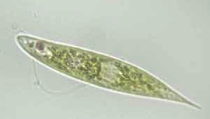
plant and animal like
have chlorophyl- photosynthetic can be heterotropic unicellular flagellated protists |
|
|
blepharisma
|
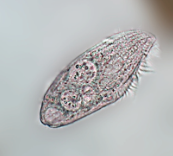
unicellular
cilia not photosynthetic |
|
|
paramecium
|
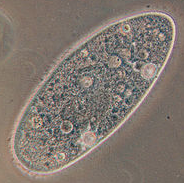
widespread in freshwater
ciliate whiplash movements diploid micronuclei polyploid macronucleus fast |
|
|
naeglaria
|
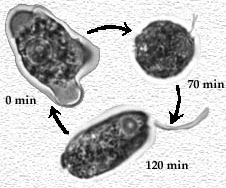
freshwater
brain eating can transition shape depending on environment |
|
|
clamydomonas
|
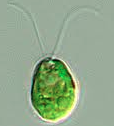
2 flagella
photosynthetic |
|
|
stentor
|
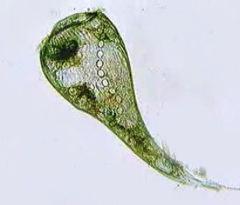
horn shaped
not photosynthetic |
|
|
microbes involved in the termite gut endosymbiosis
|
methanobrevibacter-archaea(produces methane)
Bacteria-Trichonympha(degrade cellulose and produce H and C02), Treponema(carry out acetogenesis-how acetate is formed), Citrobacter(fixes N), Lactococcus(Lactic acid) |
|
|
coevolution
|
2 or more species having a close ecological relationship evolve together such that one species adapt to the changes of the other
|
|
|
host switching
|
organism cont to exploit the same resources, but in new hosts/environments. ecological fitting.
|
|
|
basic alteration of generations life cycle
|
bryophytes(mosses and liverworts), dominant generation is haploid so gametophyte comprises what we think of as the main plant. the opposite is true for tracheophytes(vascular plants), in which the diploid generation is dominant and the sporophyte comprises the main plant
2 life cycles or generations either being the sporophyte(meiosis) or the gametophyte(mitosis). |
|
|
Algal relatives of land plants
|
charophytes, contains rings of cellulose-synthesizing complexes. do not exhibit alteration of generation. no multi cellular sporophyte
phragmoplast(plant cell structure that forms during cytokinesis to form cell wall) method of cell division |
|
|
3 types of apical growth
|
meristems-primary(tip) growth(height)
protoderm-outside of stem and develops into epidermis procambium-inside protoderm and develops into primary xylem and poem, makes vascular and cork cambium. gives rise to pericycle-produces lateral roots in eudicots ground meristem-develops into cortex and pith |
|
|
2 basic types of leaves
|
simple and compound
|
|
|
evolution of leaves
|
earliest vascular plants-simple, branched photosynthetic stems, allowed them to inc in size and area, cylindrical stem is not the most efficient shape for capturing the light needed for photosynthesis. branching systems reduced and flattened, asymmetric growth(overtopping). webbing of photosynthetic tissue developed between branches(megaphylls)
|
|
|
leaves in different environments
|
hot-spikey, thick, short
moist/humid-thin, taller lycopodium-microphylls, small leafier-megaphylls, shorter, denser middle to obtain leftover sunlight |
|
|
monocots
|
flowering plants belonging to the class Liliopsida of angiosperms, one cotyledon in seed, endogenous growth
x3 scattered vascular bundles adventitous roots leaves have parallel veins |
|
|
dicots
|
flowering plants
2 photosynthetic cotyledons in seed taproot growth x4 or x5 circular vascular bundles secondary growth taproot system net like veins |
|
|
bifacial vascular cambium
|
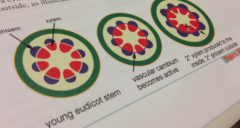
produces secondary xylem and phlowm
phloem grows outward xylem grows inwards and allows plant to grow thicker to support tall heights |
|
|
pollination syndrome
|
suites of flower traits that evolved in response to natural selection imposed by different pollen vectors, which can be abiotic(wind or water) or biotic(ex;birds, insects). traits-flower shape, size, color, nectar, timing
|
|
|
different types of fruit
|
simple-developed from ovary of single flower ex;apple
aggregate-flowers that had multi independent ovaries in a single flower ex;raspberry multiple-start of as closely spaced individual fruits, as they grow they fuse together ex-pineapple |
|
|
specific traits humans select for in plants
|
cabbage-terminal buds
broccoli-stems/flowers brussel sprouts-lateral buds cauliflower-flower clusters kale-leaves |
|
|
Annelida
|
bilateral, complete 1 way gut, paired setae, feathery feeding appendages, segmented bodies, eversible jaws, tentacles
ex-feather duster, rag, and spaghetti worms |
|
|
arthropoda
|
complete one way gut, scavenger, bilateral, segmented body(divided magmata), jointed appendages, cuticular exoskeleton composed of chiton, suspension feeder, predator
ex;crabs |
|
|
chordata
|
suspension feeder, complete one way gut, notochord, bilateral
|
|
|
hydroid
|
suspension feeder, predator, incomplete 2way gut, radial symmetry, diploblastic, cnidocytes, photosynthetic symbionts, 2 body forms;poly and medusa, no polyp stage ex;jelly fish
|
|
|
echinoderma
|
grazing, complete gut, pentaradial, no head or brain, water vascular system, tube feet, spines, locomotion with movement of spine, spines, suspension feeder, deposit feeder. brittle stars have incomplete gut
ex;urchins, sea cucumbers, sand dollar, brittle stars, star fish |
|
|
mollusca
|
grazer, suspension feeder, predator, complete gut, bilateral, specialized muscular for locomotion, radula, shell, ex;snails, muscles
|
|
|
porifera
|
suspension feeder, no gut, asymmetrical, choanocytes, spicules ex;sponges
|
|
|
cladogram
|
depicts only the sequence of splitting events
|
|
|
phylogram
|
length of each branch i a tree is intended to be proportional to the amount of evolution that has occurred
|
|
|
polyphyletic
|
no MRCA
|
|
|
7 major plant groups
|
charophycean algea
embryophytes non vascular plants;bryophytes-liverworts, mosses, hornworts seedless vascular plants-lycophytes(mosses), horsetails,ferns seed plants gymnosperms-cycads, ginkgo, gnetophytes, conifers angiosperms-flowering plants |
|
|
non vascular plants;liverworts, mosses, hornworts
|
cuticles, low growing, rhizoids, gametophytes, specialized tissues that are specialized for internal transport of water, air dispersed spores, antheridia and archegonia
|
|
|
seedless vascular plants
|
lycophytes and monilophytes; psilotum, horsetail, ferns
branched sporophyte, vascular tissue, typical tracheids monilophytes-overtopping roots, multiflagellate sperm, chloroplastDNA inversion |
|
|
gymnosperms
|
cycads, ginkgo, gnetophytes, conifers
secondary growth, xylem and phloem, pollen bifacial vascular cambium, heterospory |
|
|
angiosperms
|
double fertilization, carpels, flowering
monocots 3s, parallel veins dicots 4s and 5s netted veins |
|
|
charophytes
|
closest living relative to algae
rings of cellulose synthesizing complexes, do not exhibit alteration of generation, no multicellular sporophyte phragmoplast method of cell division |
|
|
3 types of apical growth
|
apical meristem-growth is not limited to specific plane; tip growth or width growth
protoderm-outside of stem and develops into the epidermis procambium-inside protodermand develops into primary xylem and phloem, makes vascular and cork cambium ground meristem-develops into cortex and pith |
|
|
2 types of leaves
|
compound and simple
compound are composed of leaflets microphyll origins-small projections formed, single vascular strand grew toward and into the nations(scaly leaflike structures), result in microphyll with unbranched vein, found in lycophytes megaphyll-ancestors had dichotomous branching, overtopping, planation, webbing, telome theory, ferns and all seed plants |
|
|
monocot
|
3's
parallel veins scattered vascular bundles, one cotyledon, endogenous(growing from inside) scattered vascular bundles |
|
|
dicot
|
4s or 5s
vascular bundles in circles secondary growth taproot system netted veins |
|
|
bivascular cambian
|
important for secondary growth, produces secondary xylem and phloem
phloem grows outwards xylem grows inwards to allow plant to grow thicker to support tall heights |
|
|
pollination syndromes
|
suites of flower traits that have in response to natural selection imposed by different pollen vectors, which can be abiotic(wind and water) or biotic(animal or insects)
flower size, shape, color, odor, nectar, flowering timing ex;red flowers with copious nectar often attract birds, foul smelling ones attract carrion flies or beetles |
|
|
simple, aggregate, multiple fruits
|
s-fruit develop from single ovary of a flower
a-fruit develop from flowers that had multi independent ovaries in single flower ex;raspberry m-multiple flowers that started off as closely spaced individual fruits that formed together to form a single fruit ex;pineapple |
|
|
secondary metabolites in plants
|
chemicals synthesized by plants that are secondary to plant survival-behind carbohydrates, proteins, lipids and nucleic acids
include toxic bad smelling tasting chemicals for plants survival |
|
|
human selected traits for plants
|
cabbage-terminal buds
broccoli-stems and flowers brussel sprouts-lateral buds cauliflower-flower clusters kale-leaves |
|
|
ephiphytes
|
plants that live on other plants, traditionally non parasitic
tropical rainforest, attach to tree trunks near the top of the canopy where there is more light exhibit variety of modifications to leaves, stems, roots depending on habitat in canopy have very elongated thin stems, drape other plants ground level modify roots and stem that are hollow to host ant colonies as a defense mechanism, can grow on lower parts of larger tree roots/trunks pollination syndrome-describe flower characteristics that may appeal to particular type of pollinator, predict type of pollinator that will aid in reproduction. combination of color, odor, quantity of nectar, location and type of pollen and flower structure can affect the pollinators ability to locate a slower and its food resources |
|
|
ascomycetes
|
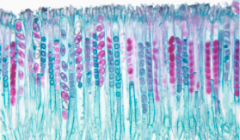
hyphae typically haploid, fusion of haploid hyphae and fusion of nuclei occurs at same time, resulting in diploid cell, 2n stage occur in fruiting body, mature ascus has 8 ascospores
|
|
|
basidiomycetes
|
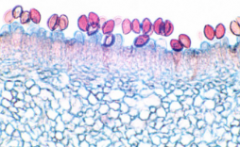
some produce asexual spores, many produce multicellular fruiting bodies(basidiomata). basidium that extrudes 4 basidiospores. long lived dikaryotic mycelium. plasmogamy occurs between cells of haploid hyphae, but 2 resulting cells do not fuse
|
|
|
lichens
|
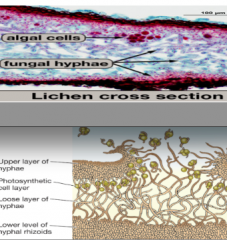
made up of a fungus and a photosynthetic partner
|
|
|
7 phyla of metazoa
|
porferia
cnidaria echinodermata arthropoda annelida mollusca chordata |
|
|
porferia
|
monoblastic, irregular cleavage, asymmetrical, no gut, filter feeder, choanocytes and spicules
|
|
|
cnidaria
|
diploblastic, irregular cleavage, radial symmetry, incomplete gut, suspension and predator
|
|
|
echinodermata
|
triploblastic, radial regulative, mosaic cleavage, pentaradial, complete one way gut, predator, scavenger, grazer, suspension, deposit
no head/brain, water vascular system, tube feet and spines, locomotion with spine movement |
|
|
arthropoda
|
triploblastic, spiral mosaic, complete one way gut, scavenger, grazer, suspension, predator
segmented body(magmata), jointed appendages, cuticular exoskeleton made of chitin, some fluoresce under UV light |
|
|
annelida
|
triploblastic, spiral mosaic, bilateral, complete 1 way gut, deposit
ex; spaghetti worm, rag worm, feather duster segmented body, paired setea, filter feeding |
|
|
mollusca
|
triploblastic, spiral mosaic, bilateral, complete 1 way gut, suspension feeder, grazer, predator
specialized muscular foot for locomotion radula(mouth with chiton teeth) present presence of a shell |
|
|
chordata
|
triploblastic, radial regulative, bilateral, complete 1 way gut, suspension feeder
notochord(rod that runs along embryo, adds support) |
|
|
developmental sequence of a metazoan
|
zygote, 2c, 4c, radial, spiral cleavage to blastula
marine worms and snails have spiral cleavage living sea urchin embryos develop from blastula to gastula |
|
|
transitions from water to land
|
desiccation issues;loss water by living on land through permeable skin and permeable membranes. land animals add various substances to their skin such as wax coatings to reduce water loss
|
|
|
symbiosis
|
dinoflagellate algae living in Anemones and corals provide carbon based products of photosynthesis, and receive protection and nitrogen based nutrient in return. gut protists living inside the guts of termites break down the cellulose consumed by termites and produce acetate that is used up as energy and a source of carbon by the host termite
|
|
|
pollination
|
bees-pollinate brightly covered plants but can't see red
hummingbirds-like to pollinate unscented flowers moths-white plants at night ` |
|
|
pollination shift
|
plant evolves to the pollinator;eventually leads to speciation and is irreversible
ex;hummingbirds and flowers |
|
|
co evolution
|
plants and flowers evolve with each other, meaning it eventually may be reversible, leads to specialization
|
|
|
morphological adaptations
|
spines evolved as an anti predator defense through convergent evolution
|
|
|
limb loss
|
not homologous trait in lizards; in tree in lab showed leglessness evolved 9 times. leglessness evolves according to habitat, easier motion in water, ability to burrow in soft-soilded/hot environments
4 advantages-more efficient locomotion, ability to utilize crevices, ability to burrow, efficient reproductive strategies ancestor to snakes must be fully 4 limbed, but with reduced stubs to lack of use |
|
|
homoplasy and convergence
|
external morphology may not indicate the best evolutionary relationship die to convergent evolution/homoplasy
|
|
|
morphology stasis
|
unchanging environments cause evolutionary stasis in different species
ex;sharks, ray, chimeras have evolved much slower than birds and sister taxa |
|
|
body modifications and character polarity
|
evolution in body form in sessile organisms depends upon the availability of food sources in the environment. trade offs include food fathering, competition, and predation
barnacles ancestral form is stalk, derived is sessile tunicate ancestral form is sessile, derived is stalk squat form-short, thick shells, hold tight to surface even after death little legs cannot extend far for food stalk-thin stalk is easily knocked over by water or organisms, greater ability to extend farther for food |
|
|
diversity within the mollusca
|
gastropoda-snails, slugs
chitons-marine grazers bivalves-clames and muscles cephalopods-squid shells developed for protection all mollusks have some sort of shell and muscle |

